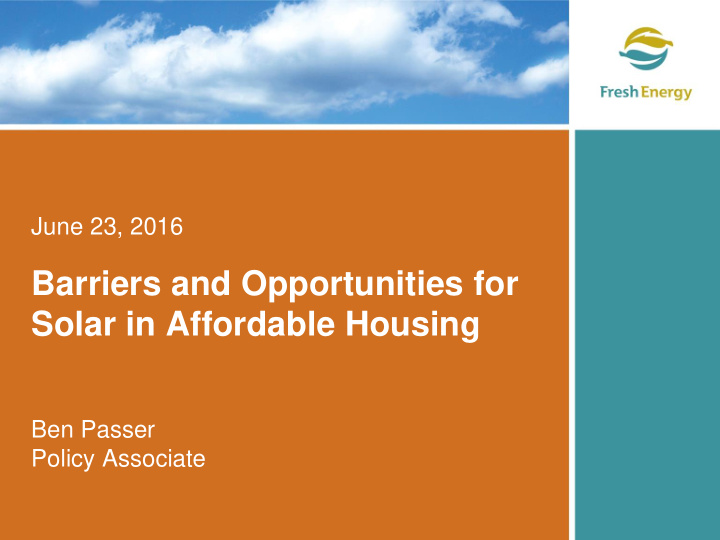



June 23, 2016 Barriers and Opportunities for Solar in Affordable Housing Ben Passer Policy Associate
Overview • About our work • Barriers to rooftop solar • Barriers in affordable housing • Selected case studies • Community solar • HUD resources
Fresh Energy Innovative. Independent. Energy Policy Experts. An independent nonprofit organization working to speed the transition to a clean energy economy in Minnesota by shaping and driving policies that benefit our communities. We work to: o Increase wind and solar o Transition away from coal and fossil fuels o Promote energy efficiency in our utility systems and buildings o Create clean and affordable transportation options
Barriers to Rooftop Solar • Shading • Geographic location • Lack of homeownership (renters) Photo credit: 256.com
Barriers for Affordable Housing Organizations • Lack of familiarity with solar energy management • Solar installation • Coordination with utility on metering • Technology and structural needs • Use of federal funding • Lack of tax appetite • Ineligible for certain tax credits • Financing for solar projects • Operating budget
Solar in Affordable Housing: Austin, Texas • Guadalupe Neighborhood Development Corporation (GNDC) partnered with Austin Energy and other firms • 100% affordable housing, owned and operated by GNDC • Net-zero design Photo credit: Enterprise
Solar in Affordable Housing: Boston, Massachusetts • Boston Community Capital works with affordable housing organizations, such as Cambridge Housing Authority, to fund solar projects • BCC owns solar systems on roofs of housing developments and leases them to housing Photo credit: Boston Community Capital organizations • BCC covers upfront capital; CHA pays back at a fixed cost
Solar in Affordable Housing: Camden, New Jersey • Partnership between Camden Community Development Corporation and GRID Tri-State • Using combination of grants and donations, GRID Tri-State outfits homes with solar installations Photo credit: GRID Tri-State
Community Solar • Centrally located solar PV system that provides electricity to participating subscribers • Customers subscribe to a share of a “garden” to cover a portion of their annual energy usage • Opportunity for those who lack ability or interest to construct a rooftop system to benefit from solar • Pay-as-you-go model: Subscriber pays in installments over time. Subscriber receives bill credit for their share of output on their energy bill the following month.
Community Solar in Minnesota • Xcel must operate a program; other investor-owned utilities (IOUs) may • 1 MW size limit per garden • Minimum of 5 subscribers • Maximum subscription size: 40% of a garden • Subscribers must live in the same or adjacent county as the solar garden • Minimum 200 watts subscription for Xcel program
Community Solar Nationwide Photo credit: GRID Alternatives, Mosaic, Center for Sustainable Energy
National Community Solar Partnership • Network created by U.S. Department of Energy to expand solar access to new markets, assess market barriers, and catalyze deployment in LMI communities • Formally kicked off at White House in November 2015 http://energy.gov/eere/solarpowerin gamerica/national-community-solar- partnership
HUD Resources • New goal to install 300 MW of renewable energy on affordable housing by 2020, including community and shared solar • Direct technical assistance for affordable housing organizations • Renew 300 website (https://www.hudexchange.info/programs/renewable- energy/) • Organizations that have made a commitment toward the federal renewable energy target can request technical assistance • Other executive actions related to funding and financing
Key Takeaways 1. Solar energy is booming in the United States, but significant barriers to participation remain 2. Community development organizations and other nonprofits can provide some assistance to spur solar development 3. Community solar is a valuable tool to help “close the solar gap” 4. Increased federal efforts, as well as commitments from individual organizations, will allow even more Americans to access the benefits of solar energy
Ben Passer, Policy Associate passer@fresh-energy.org www.fresh-energy.org
Recommend
More recommend